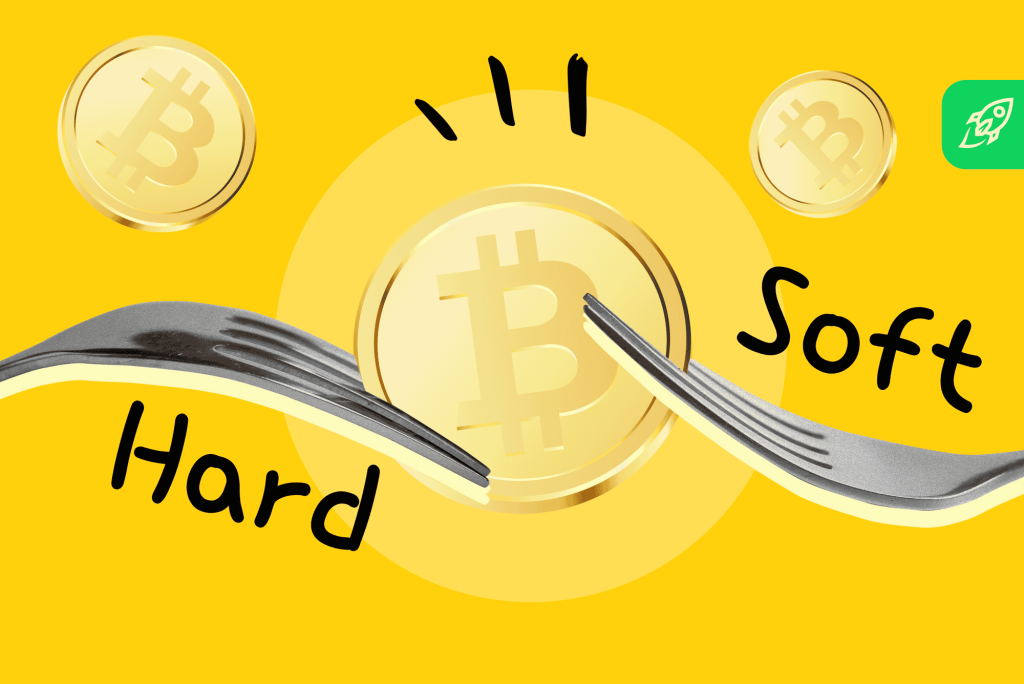A soft fork is a change to the protocol of a blockchain that is backward-compatible. This means that old nodes, which are not running the latest version of the software, will still accept blocks from new nodes, which are running the latest version of the software.
A hard fork is a change to the protocol of a blockchain that is not backward-compatible. This means that old nodes will not accept blocks from new nodes, which will lead to a split in the blockchain.
key differences between soft forks and hard forks
| Characteristic | Soft fork | Hard fork |
|---|---|---|
| Backward compatibility | Yes | No |
| Disruption to the network | Low | High |
| Risk of double spending | Low | Medium |
| Consensus required | Majority | Supermajority |
Examples of soft forks:
- Segregated Witness (SegWit)
- Pay-to-script-hash (P2SH)
- Taproot
Examples of hard forks:
- Ethereum Classic (ETC)
- Bitcoin Cash (BCH)
- Bitcoin SV (BSV)
Which type of fork is better?
Soft forks are generally preferred over hard forks because they are less disruptive to the network and pose a lower risk of double spending. However, soft forks are not always possible, especially when the changes being made are significant.
Hard forks are more disruptive to the network and pose a higher risk of double spending, but they may be necessary to implement certain changes. For example, a hard fork may be necessary to fix a critical security vulnerability or to implement a major change to the blockchain’s architecture.
Overall, the best type of fork for a particular situation depends on the specific changes that need to be made and the risks that are acceptable.
Understanding hard forks
A hard fork is a permanent change to the rules of a blockchain that makes previously valid blocks and transactions invalid. This results in two separate blockchains: one that follows the old rules and one that follows the new rules.
Hard forks can occur for a variety of reasons, such as to implement new features, fix security vulnerabilities, or change the consensus algorithm. However, they can also be controversial, as they can lead to the creation of two competing cryptocurrencies.
Here is a step-by-step explanation of how a hard fork works:
- The developers of a blockchain propose a change to the protocol.
- The change is discussed and voted on by the community.
- If the change is approved, all nodes on the network must upgrade to the new version of the software.
- Once a majority of nodes have upgraded, the network splits into two branches: one that follows the old rules and one that follows the new rules.
- Miners on the new chain can now mine new blocks and verify transactions according to the new rules.
- Miners on the old chain will continue to mine new blocks and verify transactions according to the old rules.
Holders of the original cryptocurrency will typically receive an equal amount of the new cryptocurrency after a hard fork. This is because the new blockchain is essentially a duplicate of the old blockchain, with the exception of the new rules.
Here are some examples of notable hard forks:
- Bitcoin Cash (BCH) hard forked from Bitcoin (BTC) in 2017.
- Ethereum Classic (ETC) hard forked from Ethereum (ETH) in 2016.
- Bitcoin Gold (BTG) hard forked from Bitcoin (BTC) in 2017.
- Litecoin Cash (LCC) hard forked from Litecoin (LTC) in 2018.
Hard forks can be a complex topic, but it is important to understand them if you are investing in or using cryptocurrencies.
Why do hard forks happen?
Hard forks happen in cryptocurrency when there is a permanent split in the blockchain. This can happen for a number of reasons, including:
- To add new features or functionality. Hard forks can be used to implement new features or functionality on a blockchain, such as increasing the block size or adding support for new smart contracts.
- To fix security vulnerabilities. Hard forks can also be used to fix security vulnerabilities in a blockchain’s code.
- To reverse transactions. In some cases, hard forks have been used to reverse transactions, such as in the case of the Ethereum DAO hack.
- To create a new cryptocurrency. Hard forks can also be used to create a new cryptocurrency. This is typically done when there is a disagreement within the community about the direction of the cryptocurrency.
For example, the Bitcoin Cash hard fork in 2017 was created in order to increase the block size of Bitcoin. This was a controversial change, with some members of the Bitcoin community believing that it would make the network more scalable and secure, while others believed that it would compromise the network’s security.
Hard forks can be complex and disruptive, so they are typically only used as a last resort. However, they can be a necessary tool for improving and evolving blockchains.
Here is a more detailed explanation of each of the reasons for hard forks:
Adding new features or functionality
Hard forks can be used to add new features or functionality to a blockchain, such as:
- Increasing the block size to allow for more transactions to be processed per second.
- Adding support for new smart contracts, which allow for more complex applications to be built on the blockchain.
- Implementing new security features to protect the network from attacks.
Fixing security vulnerabilities
Hard forks can also be used to fix security vulnerabilities in a blockchain’s code. This is important because security vulnerabilities can be exploited by attackers to steal funds or disrupt the network.
Reversing transactions
In some cases, hard forks have been used to reverse transactions. This is typically done when there has been a major hack or exploit that has resulted in the loss of funds. For example, the Ethereum DAO hack in 2016 resulted in the loss of millions of dollars worth of Ether. The Ethereum community subsequently voted to hard fork the blockchain to reverse the hack and return the funds to their rightful owners.
Creating a new cryptocurrency
Hard forks can also be used to create a new cryptocurrency. This is typically done when there is a disagreement within the community about the direction of the cryptocurrency. For example, the Bitcoin Cash hard fork in 2017 was created as a result of a disagreement about the block size of Bitcoin.
Hard forks are a powerful tool that can be used to improve and evolve blockchains. However, they should be used with caution, as they can also be complex and disruptive.
Accidental hard forks
Accidental hard forks occur when a blockchain network undergoes a hard fork without the intention of the developers. This can happen for a variety of reasons, such as:
- Software bugs: A bug in the blockchain software can cause the network to split into two chains, each with its own set of rules.
- Human error: An administrator mistake, such as accidentally deploying a new version of the software without properly testing it, can also lead to an accidental hard fork.
- Mining errors: If two miners find a block at the same time, the network may split into two chains, one for each block. However, this type of accidental hard fork is usually resolved quickly as miners switch to the longest chain.
Accidental hard forks can have a number of negative consequences, including:
- Network disruption: An accidental hard fork can cause the network to become disrupted, making it difficult or impossible to send or receive transactions.
- Loss of funds: If users do not upgrade their software to the new version, their funds may be stranded on the old chain.
- Confusion and uncertainty: Accidental hard forks can cause confusion and uncertainty among users and investors.
Examples of accidental hard forks
- Bitcoin accidental hard fork in 2013: This hard fork was caused by a bug in the BerkeleyDB database that was used by Bitcoin at the time. The hard fork was resolved quickly, but it did cause some disruption to the network.
- Bitcoin Core accidental hard fork in 2018: This hard fork was caused by a bug in the Bitcoin Core software. The bug was fixed before it caused any major disruption to the network.
- Ethereum accidental hard fork in 2020: This hard fork was caused by a bug in the Geth Ethereum client. The hard fork was resolved quickly, but it did cause some confusion and uncertainty among users.
How to mitigate the risks of accidental hard forks
- Rigorous software testing: Developers should thoroughly test all new software before deploying it to the main network.
- Transparency and communication: Developers should be transparent with the community about any potential risks associated with new software releases.
- Contingency plans: Developers should have contingency plans in place in case of an accidental hard fork.
Overall, accidental hard forks are a rare occurrence, but they can have a negative impact on blockchain networks. By taking steps to mitigate the risks, developers can help to protect users and investors.
Difference between hard forks and soft forks
Soft fork
A soft fork is a change to the blockchain protocol that is backward compatible. This means that nodes running the old version of the software will still be able to verify blocks created by nodes running the new version of the software. Soft forks are often used to implement new features or security fixes without causing a disruption to the network.
Hard fork
A hard fork is a change to the blockchain protocol that is not backward compatible. This means that nodes running the old version of the software will no longer be able to verify blocks created by nodes running the new version of the software. Hard forks are typically used to implement major changes to the network, such as adding new features or changing the rules of consensus.
Key differences
| Feature | Soft fork | Hard fork |
|---|---|---|
| Backward compatibility | Yes | No |
| Disruption to network | Minimal | Possible |
| Node requirements | All nodes must upgrade | Some nodes may not need to upgrade |
| Common use cases | Implementing new features or security fixes | Implementing major changes to the network, such as adding new features or changing the rules of consensus |
Examples
- Soft fork: Segregated Witness (SegWit) was a soft fork to the Bitcoin protocol that was implemented in 2017. SegWit made it possible to add more transactions to each block without increasing the block size.
- Hard fork: Bitcoin Cash was a hard fork from the Bitcoin protocol that was implemented in 2017. Bitcoin Cash increased the block size to allow for more transactions to be processed per second.
Conclusion
Soft forks and hard forks are both important tools for improving and updating blockchain networks. Soft forks are often used to implement new features or security fixes without causing a disruption to the network. Hard forks are typically used to implement major changes to the network, such as adding new features or changing the rules of consensus.
Notable hard fork examples
Notable hard fork examples:
- Bitcoin Cash (BCH): Bitcoin Cash forked from Bitcoin in 2017, primarily due to disagreements over how to scale the Bitcoin network. Bitcoin Cash increased the block size limit from 1MB to 8MB, which allows for more transactions to be processed per second.
- Ethereum Classic (ETC): Ethereum Classic forked from Ethereum in 2016, following the DAO hack. The DAO hack was a major exploit that resulted in the theft of millions of dollars worth of Ethereum. The Ethereum community decided to hard fork the blockchain to reverse the hack, but some members of the community disagreed with this decision. As a result, they forked the Ethereum blockchain and continued to run the original chain, which is now known as Ethereum Classic.
- Bitcoin Gold (BTG): Bitcoin Gold forked from Bitcoin in 2017, with the goal of making Bitcoin more resistant to ASIC mining. ASIC miners are specialized computers that are designed to mine Bitcoin efficiently. However, they are also very expensive and can make it difficult for smaller miners to compete. Bitcoin Gold changed the mining algorithm to make it more difficult for ASIC miners to operate.
- Bitcoin SV (BSV): Bitcoin SV forked from Bitcoin Cash in 2018, primarily due to disagreements over the future direction of Bitcoin Cash. Bitcoin SV supporters wanted to increase the block size limit even further and make other changes to the Bitcoin Cash protocol. Bitcoin SV opponents argued that these changes would make Bitcoin Cash less secure and decentralized.
These are just a few examples of notable hard forks. There have been many other hard forks in the history of cryptocurrencies, and there will likely be more in the future.
Note: Hard forks can be risky for users, as they can lead to the loss of funds if users are not careful. It is important to do your research before participating in any hard fork.
The DAO Hack
The DAO Hack was a security breach of the Ethereum blockchain in June 2016 that resulted in the theft of over 3.6 million ETH, worth around $60 million at the time. The hack was carried out by exploiting a vulnerability in the code of The DAO, a decentralized autonomous organization (DAO) that had raised over $150 million in ETH through a token sale.
The hacker was able to use the vulnerability to siphon off funds from The DAO by repeatedly calling the contract’s withdraw() function in a recursive loop. This allowed the hacker to withdraw more ETH than they had actually deposited into The DAO.
The DAO Hack was a major setback for the Ethereum ecosystem, and it raised serious concerns about the security of smart contracts. However, it also led to a number of positive developments, such as the introduction of new security best practices and the development of new tools and infrastructure to help prevent future attacks.
Impact of the DAO Hack
The DAO Hack had a significant impact on the Ethereum ecosystem. It led to a decline in the price of ETH, and it raised concerns about the security of smart contracts. The hack also sparked a debate within the Ethereum community about whether or not to hard fork the blockchain to reverse the attack.
In the end, the Ethereum community decided to hard fork the blockchain, creating two new chains: Ethereum and Ethereum Classic. Ethereum Classic continued to use the original blockchain code, while Ethereum adopted a new version of the code that fixed the vulnerability that had been exploited in the DAO Hack.
Lessons Learned from the DAO Hack
The DAO Hack taught a number of valuable lessons to the Ethereum community. One of the most important lessons was that smart contracts are complex pieces of software, and they need to be carefully audited before they are deployed. The hack also showed that it is important to have a plan in place in case a smart contract is hacked.
The DAO Hack also led to the development of a number of new security tools and infrastructure. For example, the Ethereum community developed a new type of smart contract called a “split wallet” that makes it more difficult for hackers to steal funds.
Overall, the DAO Hack was a major setback for the Ethereum ecosystem, but it also led to a number of positive developments. The Ethereum community learned a lot from the hack, and it took steps to make the platform more secure.
Hashrate Wars: ABC vs. SV
The Hashrate Wars: ABC vs. SV was a period of intense competition between two Bitcoin Cash factions, Bitcoin Cash ABC (ABC) and Bitcoin Cash SV (SV), for control of the network. The war began in November 2018, when the Bitcoin Cash community split into two factions over disagreements about the future of the cryptocurrency.
The ABC faction was led by Roger Ver, a prominent cryptocurrency investor and advocate. The ABC faction supported a more conservative approach to development, with a focus on maintaining compatibility with Bitcoin and improving scalability.
ALSO READ:What Are Liquidity Provider (Lp) Tokens, And How Do They Work?
The SV faction was led by Craig Wright, a self-proclaimed “Satoshi Nakamoto,” the creator of Bitcoin. The SV faction supported a more radical approach to development, with a focus on increasing the block size and adding new features to the Bitcoin Cash protocol.
The two factions competed for control of the Bitcoin Cash network by mining blocks. The faction with the most hashrate, or computing power, would be able to control the network and dictate the direction of future development.
The Hashrate Wars lasted for several months, with both factions vying for control of the network. In the end, the ABC faction emerged victorious, with a majority of hashrate on its side. The ABC chain is now considered to be the legitimate Bitcoin Cash chain, and it is the one that is listed on most cryptocurrency exchanges.
The Hashrate Wars were a significant event in the history of Bitcoin Cash. They highlighted the importance of hashrate in decentralized networks and the potential for conflict when there is no clear consensus on the future of a project.
Current status
As of today, November 4, 2023, Bitcoin Cash ABC is the dominant chain with a hashrate of over 2 EH/s. Bitcoin Cash SV has a hashrate of around 0.1 EH/s.
Bitcoin Cash ABC is also the more widely accepted chain, with most cryptocurrency exchanges listing it as the primary Bitcoin Cash asset. Bitcoin Cash SV is listed on fewer exchanges and has a lower market capitalization.
Overall, Bitcoin Cash ABC is the clear winner of the Hashrate Wars and is the chain that is most likely to succeed in the long term.
In Conclusion:
Bitcoin Cash ABC has proven to be the stronger and more stable chain, with a significantly higher hashrate and broader acceptance among cryptocurrency exchanges. This dominance in both technical capabilities and market presence positions Bitcoin Cash ABC as the frontrunner in the Hashrate Wars. While Bitcoin Cash SV may have its supporters, its lower hashrate and limited availability on exchanges suggest a less promising future. As the dust settles, it becomes increasingly clear that Bitcoin Cash ABC is the chain with the greatest potential for long-term success and widespread adoption.
Do you find Six9ja useful? Click here to give us five stars rating!











